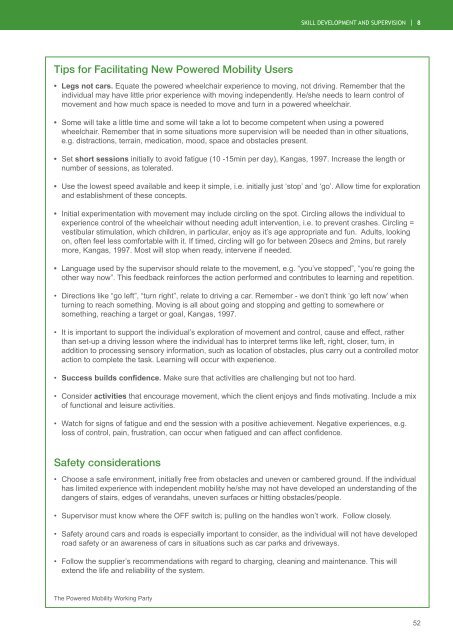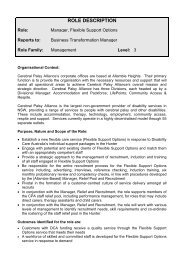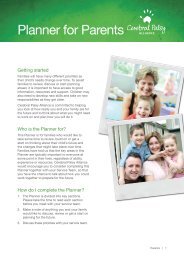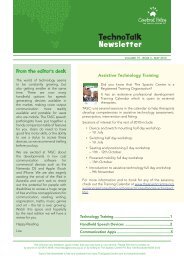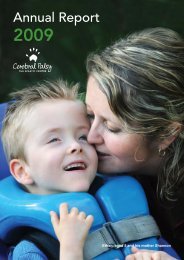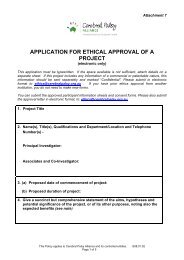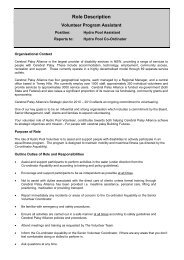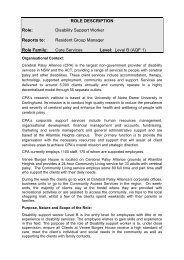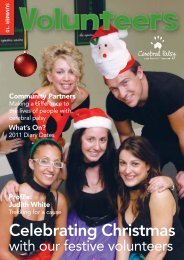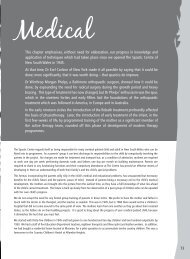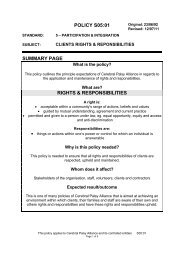Powered Mobility Manual - Cerebral Palsy Alliance
Powered Mobility Manual - Cerebral Palsy Alliance
Powered Mobility Manual - Cerebral Palsy Alliance
- No tags were found...
Create successful ePaper yourself
Turn your PDF publications into a flip-book with our unique Google optimized e-Paper software.
SKILL DEVELOPMENT AND SUPERVISION | 8Tips for Facilitating New <strong>Powered</strong> <strong>Mobility</strong> Users• Legs not cars. Equate the powered wheelchair experience to moving, not driving. Remember that theindividual may have little prior experience with moving independently. He/she needs to learn control ofmovement and how much space is needed to move and turn in a powered wheelchair.• Some will take a little time and some will take a lot to become competent when using a poweredwheelchair. Remember that in some situations more supervision will be needed than in other situations,e.g. distractions, terrain, medication, mood, space and obstacles present.• Set short sessions initially to avoid fatigue (10 -15min per day), Kangas, 1997. Increase the length ornumber of sessions, as tolerated.• Use the lowest speed available and keep it simple, i.e. initially just ‘stop’ and ‘go’. Allow time for explorationand establishment of these concepts.• Initial experimentation with movement may include circling on the spot. Circling allows the individual toexperience control of the wheelchair without needing adult intervention, i.e. to prevent crashes. Circling =vestibular stimulation, which children, in particular, enjoy as it’s age appropriate and fun. Adults, lookingon, often feel less comfortable with it. If timed, circling will go for between 20secs and 2mins, but rarelymore, Kangas, 1997. Most will stop when ready, intervene if needed.• Language used by the supervisor should relate to the movement, e.g. “you’ve stopped”, “you’re going theother way now”. This feedback reinforces the action performed and contributes to learning and repetition.• Directions like “go left”, “turn right”, relate to driving a car. Remember - we don’t think ‘go left now’ whenturning to reach something. Moving is all about going and stopping and getting to somewhere orsomething, reaching a target or goal, Kangas, 1997.• It is important to support the individual’s exploration of movement and control, cause and effect, ratherthan set-up a driving lesson where the individual has to interpret terms like left, right, closer, turn, inaddition to processing sensory information, such as location of obstacles, plus carry out a controlled motoraction to complete the task. Learning will occur with experience.• Success builds confidence. Make sure that activities are challenging but not too hard.• Consider activities that encourage movement, which the client enjoys and finds motivating. Include a mixof functional and leisure activities.• Watch for signs of fatigue and end the session with a positive achievement. Negative experiences, e.g.loss of control, pain, frustration, can occur when fatigued and can affect confidence.Safety considerations• Choose a safe environment, initially free from obstacles and uneven or cambered ground. If the individualhas limited experience with independent mobility he/she may not have developed an understanding of thedangers of stairs, edges of verandahs, uneven surfaces or hitting obstacles/people.• Supervisor must know where the OFF switch is; pulling on the handles won’t work. Follow closely.• Safety around cars and roads is especially important to consider, as the individual will not have developedroad safety or an awareness of cars in situations such as car parks and driveways.• Follow the supplier’s recommendations with regard to charging, cleaning and maintenance. This willextend the life and reliability of the system.The <strong>Powered</strong> <strong>Mobility</strong> Working Party52


